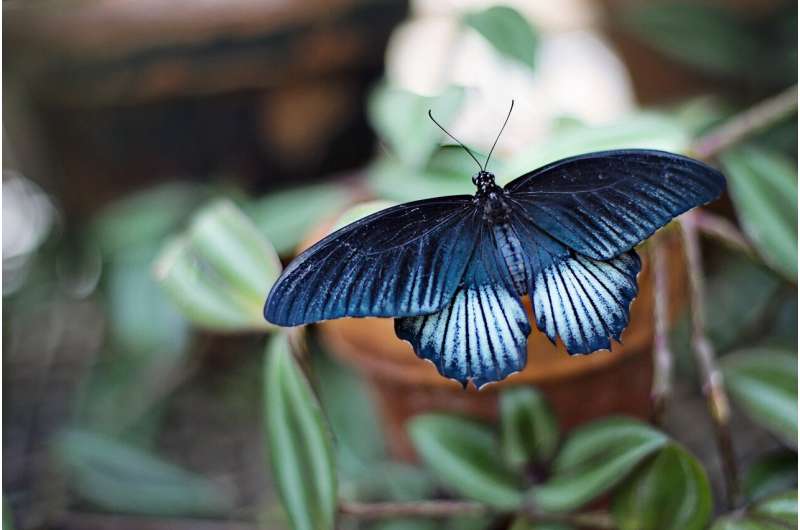Butterfly-inspired nanotech makes natural-looking pictures on digital screens

Taking inspiration from nature's nanotech that creates the stunning color of butterfly wings, a University of Central Florida researcher is creating technology to make extremely low-power, ultra-high-definition displays and screens that are easier on the eyes.
The new technology creates digital displays that are lit by surrounding light and are more natural looking than current display technologies that rely on energy-intensive bright lights hidden behind screens. The findings were published Wednesday in the journal Proceedings of the National Academy of Sciences.
"This display is more of a natural look than your current computer or smartphone screens," said Debashis Chanda, an associate professor in UCF's NanoScience Technology Center and principal investigator of the research. "It is like seeing a portrait on the wall at your house. It doesn't have that glare or extra light. It is more like looking at the natural world."
Instead of using bright LED lights located behind a screen to illuminate a display, Chanda's display is lit by reflecting light from the environment. The researcher compared the new viewing experience to switching from eating processed foods to eating natural ones.
"It'll be a step up for people to get used to it," he said. "But this is a way to create displays that are harmonious with how nature displays color and as a result look more natural and don't pump out a huge quantity of light into your eyes."
This is important because staring at brightly lit computer and smartphone displays for prolonged periods of time can cause eye strain, headaches and other health problems.
This new displaying mechanism uses a technique used by many animals, such as butterflies, octopuses, parrots, macaws and beetles, to display color by scattering and reflecting light that hits nanoscale structures on their bodies.
This type of light production is different than pigment colors or dyes, like those used in clothes or paints, that selectively absorb some colors of light and reflect others.
"If we see butterflies, octopuses or many beautiful birds, their color actually originates from nanoscale structures on their feathers, skin or scales," Chanda said. "The protein molecule, the base element, they don't have their own color but when you put them together in an orderly, controlled fashion, it creates all kinds of color. What the butterfly does is simply scatter light back in a way that it creates all this beautiful color without absorbing anything."
The technology, known as plasmonic color displays, can show different colors based on the size, shape and patterns of reflective metallic nanostructures inside the screens. The technology, however, has been limited by problems with displaying the correct color at different angles, fabricating it over large areas and displaying black.
Building upon his previous research, Chanda's group has overcome these challenges by finding a way to make the nanostructures into precise designs to fully control angle-independent scattering of light, resulting in colors that don't depend on viewing angle.
"We discovered a technique where nanoparticles could self-assemble a quasi-random pattern on a pre-designed substrate and then we could optimize that in a very controlled process to create a certain color, like yellow, blue, gold, magenta, white and more, just by changing nanoparticle size, unlike pigment-based colors where different absorbing molecules are needed for different colors," Chanda said.
The self-assembly process used in the study is similar to how the human body controls growth. In the body, enzymes and hormones released at certain times regulate growth. In Chanda's study deposition rate, pressure and temperature control the design and growth of nanostructures, which provides control of the color of light displayed.
"With the mechanism we developed, we can use physical parameters to map back to a particular pattern and subsequently a color," Chanda said.
"However, black color needed a different approach. The scattered light from the nanostructured surface is blocked using a liquid crystal layer in a controlled manner resulting in the first demonstration of black/grey colors in structural color displays," Chanda said.
With the field still emerging, the researcher said it could be a while before displays and consumer products using plasmonic nanostructures are available to the public, but the results of the study are a significant step in that direction.
More information: Daniel Franklin et al, Self-assembled plasmonics for angle-independent structural color displays with actively addressed black states, Proceedings of the National Academy of Sciences (2020). DOI: 10.1073/pnas.2001435117
Journal information: Proceedings of the National Academy of Sciences
Provided by University of Central Florida




















